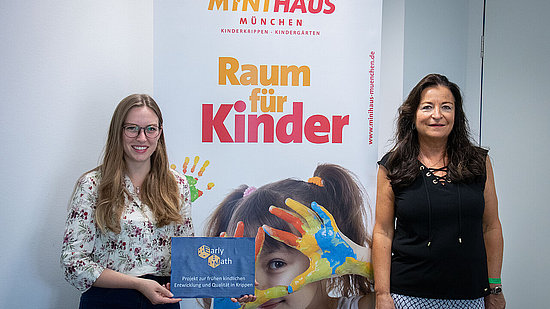Minihaus News
Even our crèche children are getting initial experiences of mathematics
When two year-old Max counts the children in the morning circle at crèche or three year-old Sophia creates a pattern out of building bricks, these activities represent the children’s initial contact with mathematics. Even our crèche children get initial experiences with numbers, quantities and shapes through play in their daily routine.
The Deutsches Jugendinstitut [DJI – German Youth Institute] and the Otto Friedrich University of Bamberg wanted to find out more about the role these early experiences of the children play in the development of their mathematical skills and how they can be supported through interaction and conversations with nursery teachers.
The project “EarlyMath: Mathematical Development and the Impact of Interaction Quality in Early Childcare” was launched as a result. The project, funded by the Deutsche Forschungsgemeinschaft [DFG – German Research Foundation], covers two areas, explains Franka Baron who is managing the project for the German Youth Institute: “On the one hand, we are interested in how maths is integrated in the nursery routine and on the other, in the early years’ development of children aged 2 and above – in other words, what can the children already do in terms of language and maths?”
Over several weeks, researchers visited some 200 children aged between two and three in 50 nurseries in Franconia and Upper Bavaria. These included the Minihaus nurseries at the Westpark, at Tölzer Strasse and at Fürstenrieder Strasse 263. For several mornings, scientists observed interactions in the crèche groups and played games with the children to record the children’s stage of development. “Over and over again, we were astounded at how much children of that age can already do”, says Franka Baron. All the children could already count a few numbers or detect complicated patterns, for example.
“Mathematics appear in lots of things, even though we don’t always realize it”, stresses Ms Baron. Examples would be the chequered floor in a picture book or the arrangement of fruit on a table. The aim of in-service training is to “think in broader terms about what can constitute mathematics” and nursery teachers should be introducing children to the subject with small nudges in their daily routine.
Just an example: the crèche is examining the topic of “Our body”. The aim is to encourage children to perceive and name the parts of their bodies with awareness. To help with this, nursery teachers can change the words to the song “Mein Hut, der hat drei Ecken” [My hat, it has three corners], for example, singing instead: “Mein Kopf, der hat drei Ohren” [My head, it has three ears]. Children then check the count, so as well as naming the individual parts of the body, they also learn to count from one to ten. This allows elements of maths to be integrated in the nursery routine through play, as the children see that they have one nose, but two ears, and five fingers on each hand.
The first part of the practical phase of the project is complete, so it is now a matter of evaluating the results. Parents who have supported the project with their children and the nursery teachers will get a summary of the results at the end, and another aim is to offer further in-service training opportunities. (jh)
